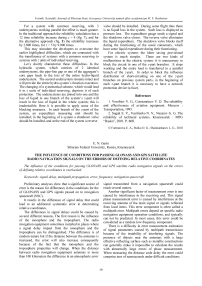The influence of conditions for passing GLONASS and GPS satellite radio navigation signals on the errors of defining relative coordinates
Автор: Garin E.N.
Журнал: Сибирский аэрокосмический журнал @vestnik-sibsau
Рубрика: Авиационная и ракетно-космическая техника
Статья в выпуске: 7 (33), 2010 года.
Бесплатный доступ
The influence of the conditions for passing GLONASS and GPS satellite radio navigation signals on the errors of defining relative coordinates is studied.
Signal delay, multipath propagation, error, frequency, navigation spacecraft
Короткий адрес: https://sciup.org/148176436
IDR: 148176436
Текст научной статьи The influence of conditions for passing GLONASS and GPS satellite radio navigation signals on the errors of defining relative coordinates
Preliminary analyses show that a significant source of error is the reason for differences in the conditions for the of GLONASS and GPS signals passed on to navigation spacecraft (NSC).
It results in the difference of signal delay that could lead to an additional systematic error in determining relative coordinates.
The differences in signal delays could be caused by several different reasons. The first reason is the influence of the ionosphere and the troposphere. The radio navigation equipment sometimes installed in places where a signal delay impact from the ionosphere and the troposphere can be distinguished. This difference is of random nature but if the distance between the antennas is increased, the error will also increase consequently because of the fact that the ionosphere and the troposphere properties will change. When the distance between radio navigation equipment antennas is more than 100 kilometers the difference in an atmospheric error signal transmitted from a navigation spacecraft could reach several meters.
Another significant factor of measurement error is one caused by interference in the receiving end. This signal phase measurement error is caused by interference at the receiving antenna of the main signal or signals reflected from local items. This error component is often called a multipath error. Multipath errors depend on specific radio navigation equipment operation conditions, and typically can not be predicted. In most cases, this error could be considered as a random low-frequency component.
There is a difficulty in error measurement estimation of signal parameters caused by multipath transmission because of the instability of interfering signals. The presence of objects near the antennas with a large effective reflecting surface such as metallic constructions can generally make it impossible to calculate the results with abnormally large errors of phase measurement. When measuring the distance code delay the error could comprise tens of nanoseconds under difficult conditions.
Mathematics, mechanics, computer science
For radio navigation equipment that performs measurements in a phase of carrier frequency of navigation spacecraft signal the impact of a direct signal and reflected signal interference can be unacceptably high. This can completely destroy the phase information on the signal delay (incremental delay) and lead to the disability of phase algorithms for the determination of navigation parameters.
Thus navigation spacecraft signals could be taken with sufficient signal to noise ratio that makes solving the navigation problem difficult and a necessity to apply a weight signal processing to reduce the negative impact on interference errors. Considering this fact the phase equipment of GLONASS and GPS systems should be provided with conditions for receiving that guarantee the absence of intense return signal. It is obvious that this is a serious limitation, reducing the possible application area of phase radio navigation equipment.
The value of multipath error is affected by the form of directional diagram of radio navigation equipment antenna and the presence of side and back lobe directional diagram. It is important to control the form of the directional diagram not only in the co-polarization (righthand circular polarization), but also on the return (left) polarization because of the fact that the reflected signals only have return polarization.
Control methods over the given error component are refusal of work with navigation space vehicle signals, having low angles of elevation (reduction of directional diagram), forming of a directional diagram with a small level of side lobes and back lobes, optimal installation of antennas on the object, minimizing the hit of reflected signals in the mouth of directional diagram antennas [1–3]. A perspectives for the given error controlling is an integration of radio navigation equipment with additional independent sources of navigating data, for example inertial sensors.


